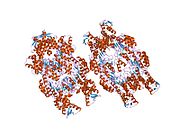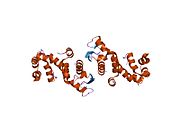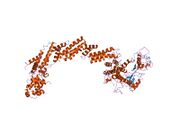Biology:SKP2
 Generic protein structure example |
S-phase kinase-associated protein 2 is an enzyme that in humans is encoded by the SKP2 gene.[1][2]
Structure and function
Skp2 contains 424 residues in total with the ~40 amino acid F-box domain lying closer to the N-terminal region at the 94-140 position and the C-terminal region forming a concave surface consisting of ten leucine-rich repeats (LRRs).[3] The F-box proteins constitute one of the four subunits of ubiquitin protein ligase complex called SCFs (SKP1-cullin-F-box), which often—but not always—recognize substrates in a phosphorylation-dependent manner. In this SCF complex, Skp2 acts as the substrate recognition factor.[4][5][6]
F-box Domain
The F-box proteins are divided into three classes: Fbxws containing WD40 repeat domains, Fbxls containing leucine-rich repeats, and Fbxos containing either different protein–protein interaction modules or no recognizable motifs.[7] The protein encoded by this gene belongs to the Fbxls class. In addition to an F-box, this protein contains 10 tandem leucine-rich repeats. Alternative splicing of this gene generates 2 transcript variants encoding different isoforms. After the tenth LRR, the ~30-residue C-terminal tail turns back towards the first LRR, forming what has been referred to as a ‘safety-belt’ that might aid to pin down substrates into the concave surface formed by the LRRs.[8]
Skp2 forms a stable complex with the cyclin A-CDK2 S-phase kinase. It specifically recognizes and promotes the degradation of phosphorylated cyclin-dependent kinase inhibitor 1B (CDKN1B, also referred to as p27 or KIP1) predominantly in S, G2 phase, and the initial part of the M phase.[9][10]
The degradation of p27 via Skp2 requires the accessory protein CKS1B.[11][12] To prevent premature degradation of p27, Skp2 levels are kept low during early and mid-G1 due to the APC/CCdh1ubiquitin ligase, which mediates the ubiquitylation of Skp2.[13][14]
Phosphorylation of Ser64 and, to a lesser extent, Ser72 of Skp2 contributes to the stabilization of Skp2 by preventing its association with APC/CCdh1; however, Skp2 phosphorylation on these residues is dispensable for its subcellular localization and for Skp2 assembly into an active SCF ubiquitin ligase.[15][16][17][18][19]
Role in cell cycle regulation
Progression through the cell cycle is tightly regulated by cyclin-dependent kinases (CDKs), and their interactions with cyclins and CDK inhibitors (CKIs). Relative amounts of these signals oscillate during each stage of the cell cycle due to periodic proteolysis;[20] the ubiquitin-proteasome system mediates the degradation of these mitotic regulatory proteins, controlling their intracellular concentrations.[21][22] These and other proteins are recognized and degraded by the proteasome from the sequential action of three enzymes: E1 (ubiquitin-activating enzyme), one of many E2s (ubiquitin-conjugating enzyme), and one of many E3 ubiquitin ligase.[23] The specificity of ubiquitination is provided by the E3 ligases; these ligases physically interact with the target substrates. Skp2 is the substrate recruiting component of the SCFSkp2 complex, which targets cell cycle control elements, such as p27 and p21.[24][25][26] Here, SKP2 has been implicated in double negative feedback loops with both p21 and p27, that control cell cycle entry and G1/S transition.[27][28]
Clinical significance
Skp2 behaves as an oncogene in cell systems[29] and is an established protooncogene causally involved in the pathogenesis of lymphomas.[30] One of the most critical CDK inhibitors involved in cancer pathogenesis is p27Kip1, which is involved primarily in inhibiting cyclin E-CDK2 complexes (and to a lesser extent cyclin D-CDK4 complexes).[31] Levels of p27Kip1 (like all other CKIs) rise and fall in cells as they either exit or re-enter the cell cycle, these levels are not modulated at the transcriptional level, but by the actions of the SCFSkp2 complex in recognizing p27Kip1 and tagging it for destruction in the proteasome system.[20] It has been shown that as cells enter G0 phase, reducing levels of Skp2 explain the increase in p27Kip1, creating an apparent inverse relationship between Skp2 and p27Kip1.[13] Robust evidence has been amassed that strongly suggests Skp2 plays an important role in cancer and is also involved in cancer-associated drug resistance.[32]
Overexpression
Overexpression of Skp2 is frequently observed in human cancer progression and metastasis, and evidence suggests that Skp2 plays a proto-oncogenic role both in vitro and in vivo.[4] Skp2 overexpression has been seen in: lymphomas,[33] prostate cancer,[34] melanoma,[35] nasopharyngeal carcinoma,[36][37] pancreatic cancer,[38] and breast carcinomas.[39][40] Additionally, overexpression of Skp2 is correlated with a poor prognosis in breast cancer.[41][42] As one would expect, Skp2 overexpression promotes growth and tumorigenesis in a xenograft tumor model.[43] By extension of this fact, Skp2 inactivation profoundly restricts cancer development by triggering a massive cellular senescence and/or apoptosis response that is surprisingly observed only in oncogenic conditions in vivo.[44] This response is triggered in a p19Arf/p53-independent, but p27-dependent manner.[44]
Using a Skp2 knockout mouse model, multiple groups have shown Skp2 is required for cancer development in different conditions of tumor promotion, including PTEN, ARF, pRB inactivation as well as Her2/Neu overexpression.[45]
Genetic approaches have demonstrated that Skp2 deficiency inhibits cancer development in multiple mouse models by inducing p53-independent cellular senescence and blocking Akt-mediated aerobic glycolysis. Akt activation by Skp2 is linked to aerobic glycolysis, as Skp2 deficiency impairs Akt activation, Glut1 expression, and glucose uptake thereby promoting cancer development.[46]
Potential use as a clinical target
Skp2 is of considerable interest as a novel and attractive target for cancer therapeutical development, as disrupting the SCF complex will result in increased levels of p27, which will inhibit aberrant cellular proliferation. Although Skp2 is an enzyme, its function requires the assembly of the other members of the SCF complex. As Skp2 is the rate-limiting component of the SCF complex, effective inhibitors should be focused on the interfaces of Skp2 with the other members of the SCF complex, which is much more difficult than traditional enzyme inhibition. Small molecule inhibitors of the binding site between Skp2 and its substrate p27 have been discovered, and these inhibitors induce p27 accumulation in a Skp2-dependent manner and promote cell cycle arrest.[47] Another recent discovery were inhibitors of the Skp1/Skp2 interface that resulted in: restoring p27 levels, suppressing survival, trigger p53-independent senescence, exhibit potent antitumor activity in multiple animal models, and were also found to affect Akt-mediated glycolysis.[48] Skp2 is a potential target for pten-deficient cancers.[44]
Interactions
SKP2 has been shown to interact with:
- CCNA2,[49][50]
- CDK2,[49][50][51]
- CDKN1A[52]
- CDKN1B[11][53][54]
- CKS1B,[11][12][53][55][56]
- CDT1,[57]
- CUL1[5][50][57][58][59][60]
- E2F1,[50]
- ORC1L,[61] and
- SKP1A.[58][62][63][64][65]
References
- ↑ "Chromosomal mapping of the genes for the human CDK2/cyclin A-associated proteins p19 (SKP1A and SKP1B) and p45 (SKP2)". Cytogenetics and Cell Genetics 73 (1–2): 104–7. Jul 1996. doi:10.1159/000134318. PMID 8646875.
- ↑ "Entrez Gene: SKP2 S-phase kinase-associated protein 2 (p45)". https://www.ncbi.nlm.nih.gov/sites/entrez?Db=gene&Cmd=ShowDetailView&TermToSearch=6502.
- ↑ "SKP1 connects cell cycle regulators to the ubiquitin proteolysis machinery through a novel motif, the F-box". Cell 86 (2): 263–74. July 1996. doi:10.1016/S0092-8674(00)80098-7. PMID 8706131.
- ↑ 4.0 4.1 "Regulation of Skp2 expression and activity and its role in cancer progression". TheScientificWorldJournal 10: 1001–15. 2010. doi:10.1100/tsw.2010.89. PMID 20526532.
- ↑ 5.0 5.1 "Structure of the Cul1-Rbx1-Skp1-F boxSkp2 SCF ubiquitin ligase complex". Nature 416 (6882): 703–9. April 2002. doi:10.1038/416703a. PMID 11961546. Bibcode: 2002Natur.416..703Z.
- ↑ "Regulation of the cell cycle by SCF-type ubiquitin ligases". Seminars in Cell & Developmental Biology 16 (3): 323–33. June 2005. doi:10.1016/j.semcdb.2005.02.010. PMID 15840441.
- ↑ "The F-box protein family". Genome Biology 1 (5): REVIEWS3002. 2000. doi:10.1186/gb-2000-1-5-reviews3002. PMID 11178263.
- ↑ "The SCF ubiquitin ligase: insights into a molecular machine". Nature Reviews Molecular Cell Biology 5 (9): 739–51. September 2004. doi:10.1038/nrm1471. PMID 15340381.
- ↑ "SKP2 is required for ubiquitin-mediated degradation of the CDK inhibitor p27". Nature Cell Biology 1 (4): 193–9. August 1999. doi:10.1038/12013. PMID 10559916.
- ↑ "p27(Kip1) ubiquitination and degradation is regulated by the SCF(Skp2) complex through phosphorylated Thr187 in p27". Current Biology 9 (12): 661–4. June 1999. doi:10.1016/S0960-9822(99)80290-5. PMID 10375532.
- ↑ 11.0 11.1 11.2 "Three different binding sites of Cks1 are required for p27-ubiquitin ligation". The Journal of Biological Chemistry 277 (44): 42233–40. November 2002. doi:10.1074/jbc.M205254200. PMID 12140288.
- ↑ 12.0 12.1 "The cell-cycle regulatory protein Cks1 is required for SCF(Skp2)-mediated ubiquitinylation of p27". Nature Cell Biology 3 (3): 321–4. March 2001. doi:10.1038/35060126. PMID 11231585.
- ↑ 13.0 13.1 "Control of the SCF(Skp2-Cks1) ubiquitin ligase by the APC/C(Cdh1) ubiquitin ligase". Nature 428 (6979): 190–3. March 2004. doi:10.1038/nature02330. PMID 15014502.
- ↑ "Degradation of the SCF component Skp2 in cell-cycle phase G1 by the anaphase-promoting complex". Nature 428 (6979): 194–8. March 2004. doi:10.1038/nature02381. PMID 15014503. Bibcode: 2004Natur.428..194W.
- ↑ "Phosphorylation of Skp2 regulated by CDK2 and Cdc14B protects it from degradation by APC(Cdh1) in G1 phase". The EMBO Journal 27 (4): 679–91. February 2008. doi:10.1038/emboj.2008.6. PMID 18239684.
- ↑ "Phosphorylation of Ser72 is dispensable for Skp2 assembly into an active SCF ubiquitin ligase and its subcellular localization". Cell Cycle 9 (5): 971–4. March 2010. doi:10.4161/cc.9.5.10914. PMID 20160477.
- ↑ "Phosphorylation of Ser72 does not regulate the ubiquitin ligase activity and subcellular localization of Skp2". Cell Cycle 9 (5): 975–9. March 2010. doi:10.4161/cc.9.5.10915. PMID 20160482.
- ↑ "Phosphorylation by Akt1 promotes cytoplasmic localization of Skp2 and impairs APCCdh1-mediated Skp2 destruction". Nature Cell Biology 11 (4): 397–408. April 2009. doi:10.1038/ncb1847. PMID 19270695.
- ↑ "A comparison between Skp2 and FOXO1 for their cytoplasmic localization by Akt1". Cell Cycle 9 (5): 1021–2. March 2010. doi:10.4161/cc.9.5.10916. PMID 20160512.
- ↑ 20.0 20.1 "Recycling the cell cycle: cyclins revisited". Cell 116 (2): 221–34. January 2004. doi:10.1016/S0092-8674(03)01080-8. PMID 14744433.
- ↑ "Themes and variations on ubiquitylation". Nature Reviews Molecular Cell Biology 2 (3): 169–78. March 2001. doi:10.1038/35056563. PMID 11265246.
- ↑ "Back to the future with ubiquitin". Cell 116 (2): 181–90. January 2004. doi:10.1016/S0092-8674(03)01074-2. PMID 14744430.
- ↑ "Deregulated proteolysis by the F-box proteins SKP2 and beta-TrCP: tipping the scales of cancer". Nature Reviews. Cancer 8 (6): 438–49. June 2008. doi:10.1038/nrc2396. PMID 18500245.
- ↑ Yu, Z.-K.; Gervais, J. L. M.; Zhang, H. (1998). "Human CUL-1 associates with the SKP1/SKP2 complex and regulates p21CIP1/WAF1 and cyclin D proteins". Proceedings of the National Academy of Sciences 95 (19): 11324–11329. doi:10.1073/pnas.95.19.11324. PMID 9736735. Bibcode: 1998PNAS...9511324Y.
- ↑ Bornstein, G.; Bloom, J.; Sitry-Shevah, D.; Nakayama, K.; Pagano, M.; Hershko, A. (2003). "Role of the SCFSkp2 Ubiquitin Ligase in the Degradation of p21Cip1 in S Phase". Journal of Biological Chemistry 278 (28): 25752–25757. doi:10.1074/jbc.m301774200. PMID 12730199.
- ↑ Kossatz, U. (2004). "Skp2-dependent degradation of p27kip1 is essential for cell cycle progression". Genes & Development 18 (21): 2602–2607. doi:10.1101/gad.321004. PMID 15520280.
- ↑ Barr, Alexis R.; Heldt, Frank S.; Zhang, Tongli; Bakal, Chris; Novakl, Bela (2016). "A Dynamical Framework for the All-or-None G1/S Transition". Cell Systems 2 (1): 27–37. doi:10.1016/j.cels.2016.01.001. PMID 27136687.
- ↑ Barr, Alexis R.; Cooper, Samuel; Heldt, Frank S.; Butera, Francesca; Stoy, Henriette; Mansfeld, Jorg; Novak, Bela; Bakal, Chris (2017). "DNA damage during S-phase mediates the proliferation-quiescence decision in the subsequent G1 via p21 expression". Nature Communications 8: 14728. doi:10.1038/ncomms14728. PMID 28317845. Bibcode: 2017NatCo...814728B.
- ↑ "Role of the F-box protein Skp2 in adhesion-dependent cell cycle progression". The Journal of Cell Biology 153 (7): 1381–90. June 2001. doi:10.1083/jcb.153.7.1381. PMID 11425869.
- ↑ "Role of the F-box protein Skp2 in lymphomagenesis". Proceedings of the National Academy of Sciences of the United States of America 98 (5): 2515–20. February 2001. doi:10.1073/pnas.041475098. PMID 11226270. Bibcode: 2001PNAS...98.2515L.
- ↑ "Cytoplasmic relocalization and inhibition of the cyclin-dependent kinase inhibitor p27(Kip1) by PKB/Akt-mediated phosphorylation in breast cancer". Nature Medicine 8 (10): 1136–44. October 2002. doi:10.1038/nm762. PMID 12244303.
- ↑ "Emerging Roles of SKP2 in Cancer Drug Resistance". Cells 10 (5): 1147. May 2021. doi:10.3390/cells10051147. PMID 34068643.
- ↑ "Prognostic significance of the F-box protein Skp2 expression in diffuse large B-cell lymphoma". American Journal of Hematology 73 (4): 230–5. August 2003. doi:10.1002/ajh.10379. PMID 12879424.
- ↑ "Skp2: a novel potential therapeutic target for prostate cancer". Biochimica et Biophysica Acta (BBA) - Reviews on Cancer 1825 (1): 11–7. January 2012. doi:10.1016/j.bbcan.2011.09.002. PMID 21963805.
- ↑ "Clinical relevance of SKP2 alterations in metastatic melanoma". Pigment Cell & Melanoma Research 24 (1): 197–206. February 2011. doi:10.1111/j.1755-148X.2010.00784.x. PMID 20883453.
- ↑ "Effect of S-phase kinase-associated protein 2 expression on distant metastasis and survival in nasopharyngeal carcinoma patients". International Journal of Radiation Oncology, Biology, Physics 73 (1): 202–7. January 2009. doi:10.1016/j.ijrobp.2008.04.008. PMID 18538504.
- ↑ "Correlation of Skp2 overexpression to prognosis of patients with nasopharyngeal carcinoma from South China". Chinese Journal of Cancer 30 (3): 204–12. March 2011. doi:10.5732/cjc.010.10403. PMID 21352698.
- ↑ "SKP2 confers resistance of pancreatic cancer cells towards TRAIL-induced apoptosis". International Journal of Oncology 38 (1): 219–25. January 2011. doi:10.3892/ijo_00000841. PMID 21109943.
- ↑ "Differential expression of the F-box proteins Skp2 and Skp2B in breast cancer". Oncogene 24 (21): 3448–58. May 2005. doi:10.1038/sj.onc.1208328. PMID 15782142.
- ↑ "Relationship between levels of Skp2 and P27 in breast carcinomas and possible role of Skp2 as targeted therapy". Steroids 70 (11): 770–4. October 2005. doi:10.1016/j.steroids.2005.04.012. PMID 16024059.
- ↑ "Significance of skp2 expression in primary breast cancer". Clinical Cancer Research 12 (4): 1215–20. February 2006. doi:10.1158/1078-0432.CCR-05-1709. PMID 16489076.
- ↑ "Oncogenic role of the ubiquitin ligase subunit Skp2 in human breast cancer". The Journal of Clinical Investigation 110 (5): 633–41. September 2002. doi:10.1172/JCI15795. PMID 12208864.
- ↑ "Phosphorylation-dependent regulation of cytosolic localization and oncogenic function of Skp2 by Akt/PKB". Nature Cell Biology 11 (4): 420–32. April 2009. doi:10.1038/ncb1849. PMID 19270694.
- ↑ 44.0 44.1 44.2 "Skp2 targeting suppresses tumorigenesis by Arf-p53-independent cellular senescence". Nature 464 (7287): 374–9. March 2010. doi:10.1038/nature08815. PMID 20237562. Bibcode: 2010Natur.464..374L.
- Lay summary in: "Disabling Skp2 gene helps shut down cancer growth". ScienceDaily (Press release). March 17, 2010.
- ↑ "Tumor suppressor ARF inhibits HER-2/neu-mediated oncogenic growth". Oncogene 23 (42): 7132–43. September 2004. doi:10.1038/sj.onc.1207918. PMID 15273726.
- ↑ "The Skp2-SCF E3 ligase regulates Akt ubiquitination, glycolysis, herceptin sensitivity, and tumorigenesis". Cell 149 (5): 1098–111. May 2012. doi:10.1016/j.cell.2012.02.065. PMID 22632973.
- ↑ "Specific small molecule inhibitors of Skp2-mediated p27 degradation". Chemistry & Biology 19 (12): 1515–24. December 2012. doi:10.1016/j.chembiol.2012.09.015. PMID 23261596.
- ↑ "Pharmacological inactivation of Skp2 SCF ubiquitin ligase restricts cancer stem cell traits and cancer progression". Cell 154 (3): 556–68. August 2013. doi:10.1016/j.cell.2013.06.048. PMID 23911321.
- ↑ 49.0 49.1 "Tuberin binds p27 and negatively regulates its interaction with the SCF component Skp2". The Journal of Biological Chemistry 279 (47): 48707–15. November 2004. doi:10.1074/jbc.M405528200. PMID 15355997.
- ↑ 50.0 50.1 50.2 50.3 "Interaction between ubiquitin-protein ligase SCFSKP2 and E2F-1 underlies the regulation of E2F-1 degradation". Nature Cell Biology 1 (1): 14–9. May 1999. doi:10.1038/8984. PMID 10559858.
- ↑ "Regulation of cyclin A-Cdk2 by SCF component Skp1 and F-box protein Skp2". Molecular and Cellular Biology 19 (1): 635–45. January 1999. doi:10.1128/mcb.19.1.635. PMID 9858587.
- ↑ "Role of the SCFSkp2 ubiquitin ligase in the degradation of p21Cip1 in S phase". The Journal of Biological Chemistry 278 (28): 25752–7. July 2003. doi:10.1074/jbc.M301774200. PMID 12730199.
- ↑ 53.0 53.1 "A negatively charged amino acid in Skp2 is required for Skp2-Cks1 interaction and ubiquitination of p27Kip1". The Journal of Biological Chemistry 278 (34): 32390–6. August 2003. doi:10.1074/jbc.M305241200. PMID 12813041.
- ↑ "Akt-dependent phosphorylation of p27Kip1 promotes binding to 14-3-3 and cytoplasmic localization". The Journal of Biological Chemistry 277 (32): 28706–13. August 2002. doi:10.1074/jbc.M203668200. PMID 12042314.
- ↑ "Dual-specificity phosphatase 1 ubiquitination in extracellular signal-regulated kinase-mediated control of growth in human hepatocellular carcinoma". Cancer Research 68 (11): 4192–200. June 2008. doi:10.1158/0008-5472.CAN-07-6157. PMID 18519678.
- ↑ "Structural basis of the Cks1-dependent recognition of p27(Kip1) by the SCF(Skp2) ubiquitin ligase". Molecular Cell 20 (1): 9–19. October 2005. doi:10.1016/j.molcel.2005.09.003. PMID 16209941.
- ↑ 57.0 57.1 "The SCF(Skp2) ubiquitin ligase complex interacts with the human replication licensing factor Cdt1 and regulates Cdt1 degradation". The Journal of Biological Chemistry 278 (33): 30854–8. August 2003. doi:10.1074/jbc.C300251200. PMID 12840033.
- ↑ 58.0 58.1 "TIP120A associates with cullins and modulates ubiquitin ligase activity". The Journal of Biological Chemistry 278 (18): 15905–10. May 2003. doi:10.1074/jbc.M213070200. PMID 12609982.
- ↑ "Association of human CUL-1 and ubiquitin-conjugating enzyme CDC34 with the F-box protein p45(SKP2): evidence for evolutionary conservation in the subunit composition of the CDC34-SCF pathway". The EMBO Journal 17 (2): 368–83. January 1998. doi:10.1093/emboj/17.2.368. PMID 9430629.
- ↑ "Association of SAP130/SF3b-3 with Cullin-RING ubiquitin ligase complexes and its regulation by the COP9 signalosome". BMC Biochemistry 9: 1. 2008. doi:10.1186/1471-2091-9-1. PMID 18173839.
- ↑ "Human origin recognition complex large subunit is degraded by ubiquitin-mediated proteolysis after initiation of DNA replication". Molecular Cell 9 (3): 481–91. March 2002. doi:10.1016/S1097-2765(02)00467-7. PMID 11931757.
- ↑ "SCF(beta-TRCP) and phosphorylation dependent ubiquitinationof I kappa B alpha catalyzed by Ubc3 and Ubc4". Oncogene 19 (31): 3529–36. July 2000. doi:10.1038/sj.onc.1203647. PMID 10918611.
- ↑ "Characterization of the cullin and F-box protein partner Skp1". FEBS Letters 438 (3): 183–9. November 1998. doi:10.1016/S0014-5793(98)01299-X. PMID 9827542.
- ↑ "Insights into SCF ubiquitin ligases from the structure of the Skp1-Skp2 complex". Nature 408 (6810): 381–6. November 2000. doi:10.1038/35042620. PMID 11099048. Bibcode: 2000Natur.408..381S.
- ↑ "Identification of a family of human F-box proteins". Current Biology 9 (20): 1177–9. October 1999. doi:10.1016/S0960-9822(00)80020-2. PMID 10531035.






